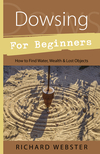Exploring the Subconscious with Dowsing

Know thyself. That good advice goes back all the way to the days of Plato and Socrates, and the ancient Greek inscription at the Temple of Delphi. But sometimes, knowing yourself is a lot harder than it should be, especially if you are out of touch with what is going on at the subconscious level.
Even though our conscious, rational mind determines what choices we make in life, the hidden part of ourselves, our subconscious mind, is equally important. If these two halves of your mind are out of sync, you may find that everything becomes more difficult. Illnesses, accidents, anxieties, and fears are some ways the subconscious tries to get our attention. If your subconscious doesn't agree with what you'd like to do, making changes becomes nearly impossible.
Dowsing is the perfect tool to talk to the subconscious mind and find out what's going on beneath the surface. In many ways, it's like the old-timer walking a field with a forked stick, trying to find water. In this case, you will use a pendulum to explore the subconscious and try to strike those deep veins of truth that are flowing beneath.
A pendulum can be anything that can dangle in a balanced way on a chain or string. Hold your pendulum in your dominant hand and tell yourself, "Show me a yes." You are programming yourself to recognize a positive answer. My yes response is a clockwise circle, but yours may move counter clockwise or back and forth. Once you've established your yes, ask for a no. It may take some time to get your pendulum moving with just your thoughts, but you'll eventually find that it gets easier with practice. For more help in learning to dowse, see my book, Intuition in an Instant.
Once you become comfortable with dowsing, you will have a valuable tool to help you explore your hidden motivations, much like a therapist might in a counseling session. You will want to get in the habit of talking to your subconscious on a regular basis. To do so, take a few moments to center yourself. Close your eyes, and take a few deep breaths. Once you are in a relaxed state, hold your pendulum and ask if you can connect with your subconscious mind. Then ask yourself for the name of your subconscious. This will help you access your subconscious more easily. Once you have a name, use your pendulum to confirm that this is what your subconscious wants to be called. In general, you may find it best to talk to your subconscious as if you were talking to a child. Be gentle with yourself and offer thanks for all the hard work it has been doing on your behalf. Then be quiet and ask what it is feeling. Something might come to mind quickly, an emotion or a thought. If you are having problems with a particular project or goal, you might want to check in with your subconscious and use your dowsing skills to explore what's going on. Deep-rooted blocks, false assumptions, and self-limiting attitudes can be buried deep in the subconscious. First you have to identify these blocks, and then you can begin to release them with the help of your pendulum. For instance, if you determine that the phrase, "I don't deserve," is rooted in your subconscious, you can do a clearing to help erase that from your mind.
Get settled in your favorite dowsing place. Take a few moments to center yourself and take a few deep, complete breaths. Calling upon your higher self to assist you, say out loud or to yourself, "I ask my higher self to examine my subconscious mind and remove the blocks that are related to ______ (the negative statement). Fill the space that is created with love and whatever I need most at this time."
Dowse again to check and see if the block remains. If it does, you can talk with your subconscious and present reasons why that statement is false. Someone who deep down feels she doesn't deserve all the success she has experienced might say to her subconscious, "We do deserve all the good we have in our life. We have worked hard to achieve our goals. We are a good person and we always try our best." Then dowse to see if the subconscious is now ready for a clearing, and repeat the process.
Another way to use dowsing to interact with your subconscious is when you want to make a major change in your life. If you are calling on willpower to lose twenty pounds, or quit smoking, or tackle a big project, check to make sure your subconscious is in agreement. If your subconscious doesn't want the change to happen, most likely it won't. That is worth repeating: you will not be successful in reaching your goals unless your subconscious is open to the idea.
Anytime you call upon willpower to make some sort of change, you are using your logical, rational, conscious mind to set it in motion. You will spend a lot of time thinking about your goal, perhaps drawing up a detailed plan that you can put into action. You tell yourself, "I can do this. I will put these steps into action and I will succeed." But there are many times when that's not enough. Is it lack of willpower, or is it a tug of war between the conscious and subconscious mind?
As a dowser, you have a distinct advantage. You can get in touch with the underlying motivations and beliefs of your subconscious simply by asking questions and using your pendulum.
Start by asking, "Are there subconscious blocks to this goal I would like to achieve?" If you get a positive response, you can follow with other questions to understand what exactly it is, and then clear it. Call upon your higher self to assist you with removing whatever obstacles the subconscious has placed upon this goal.
Understanding what is going on inside the subconscious mind is a good place to start dowsing, because the process helps to remove obstacles—both to the goals we want achieve and to the intuition we want flowing in our lives. The clearer we are, the more accurate our dowsing will be. That journey starts by "knowing thyself."
Related Products


is subject to certain Terms and Conditions